Configuring a Transform Component
|
Topics: |
The Properties dialog box enables you to view or modify the set of properties defined for a Transform component.
To access the Properties dialog box, right-click a Transform component, and select Properties from the context menu, as shown in the following image.
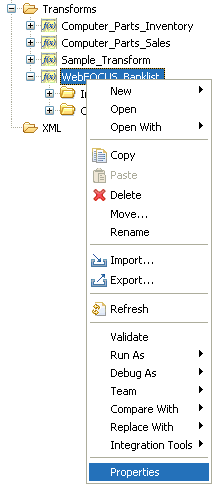
The Properties dialog box opens, as shown in the next image.
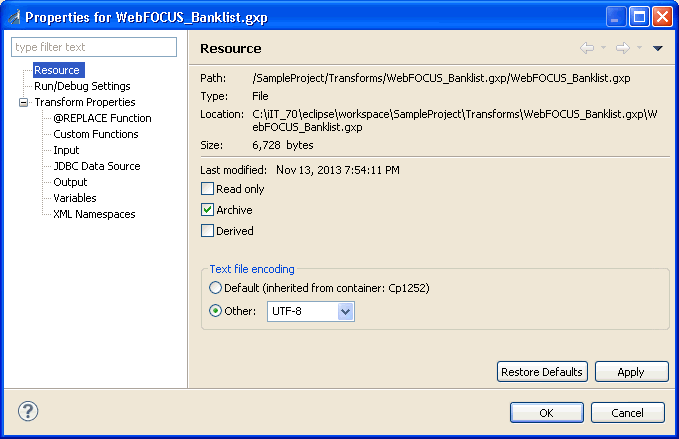
The Properties dialog box includes the following categories:
- Resource. For more information, see Resource.
- Run/Debug Settings. For more information, see Run/Debug Settings.
- Transform Properties. For
more information, see Transform
Properties.
- @REPLACE Function. For more information, see @REPLACE Function.
- Custom Functions. For more information, see Custom Functions.
- Input. For more information, see Input.
- JDBC Data Source. For more information, see JDBC Data Source.
- Output. For more information, see Output.
- Variables. For more information, see Variables.
- XML Namespaces. For more information, see XML Namespaces.
Resource
The Resource category displays system-level information about the Transform component resource file, as shown in the following image.

The following information is available:
- Path
- Type
- Location
- Size
- Last Modified
You can set Read only, Archive, and Derived file access options for the resource if required. By default, the Archive option is set.
The Text file encoding section allows you to specify the type of encoding that is used for the characters in a file. By default, the character encoding is set to UTF-8.
Run/Debug Settings
The Run/Debug Settings category allows you to manage launch configurations that are associated with the resource that is currently selected. The Run/Debug Settings pane is shown in the following image.
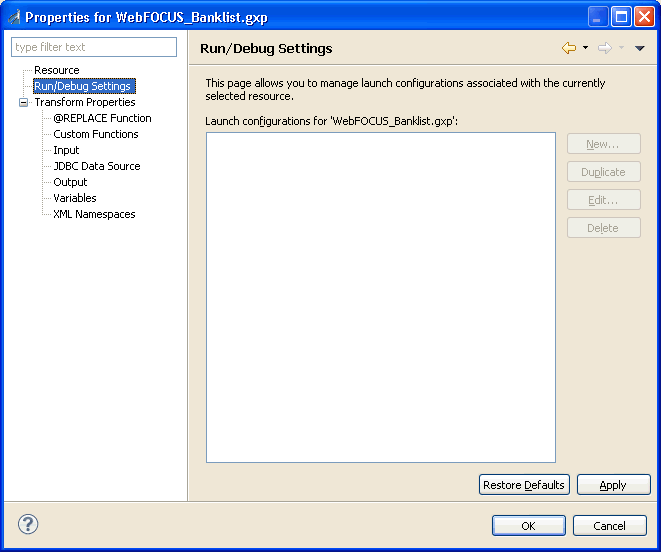
Transform Properties
The Transform Properties category includes basic information about the Transform component, as shown in the following image.
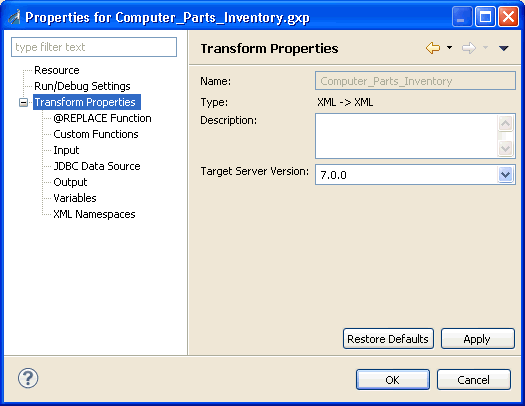
The following properties are listed:
- Name. Name of your Transform component.
- Type. Input and output format of your Transform component. If the format of the input or output is changed, the Type property will reflect that change.
- Description. Custom description for your Transform component.
- Target Server Version. Target version of iWay Service Manager (iSM) that is selected for this Transform component.
@REPLACE Function
The @REPLACE Function category provides a way to instantaneously match and replace certain input data values. Each individually configured replace function works similarly to a custom function in that you must first define the function, and then apply it in the output node mapping value definition that you want to affect.
The following image shows the @REPLACE Function pane.
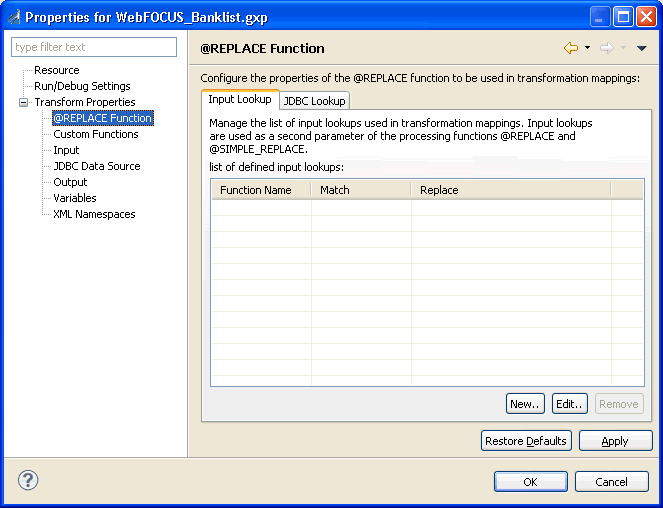
Click New Match to define an input lookup for the replace function.
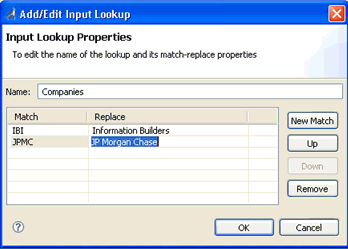
Custom Functions
The Custom Functions category enables you to manage the list of custom functions that you can build on-demand, when a predefined iWay Transformer function does not exist to perform the task that you require.
The following image shows the Custom Functions pane.
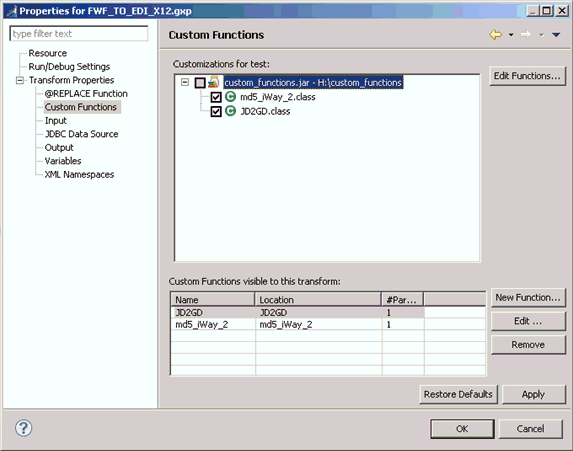
Custom functions must be written using Java and saved as Java class files (.class) in the following directory to make them available for use with iWay Transformer during design time.
iWaySMHome\tools\transformer\custom_functions
where:
- iWaySMHome
-
Is the directory in which iWay Service Manager is installed.
You must configure custom functions differently for use at run time.
Input
|
Topics: |
The Input category allows you to configure the input properties for the Transform component.
The following image shows the Input pane, with the Structure tab selected.
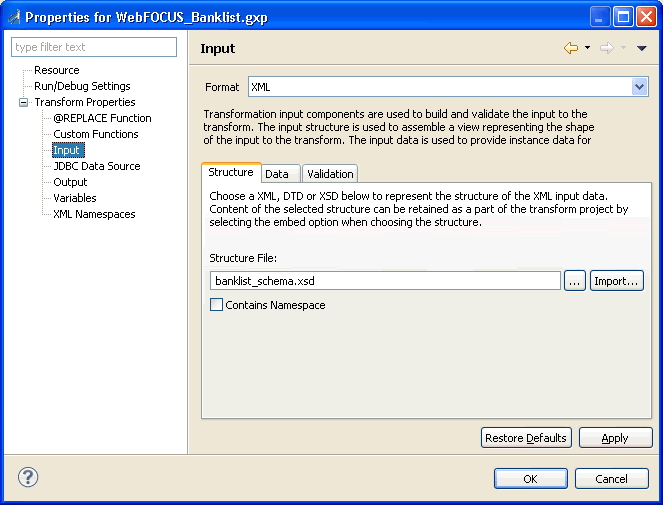
Input Structure
|
Topics: |
The Structure tab allows you to configure the dictionary, also called the structure, for your input.
For more information on using dictionaries, see Dictionary.
Configuring the Input Structure
On the Structure tab, you can specify metadata components
by clicking the Import button to locate the
file on your file system, or by typing the name of the file in the
component field. You can also load the structure from the workspace
using the Browse  button.
button.
The following image shows the Open dialog box that is displayed when you click the Import button next to a dictionary component field.
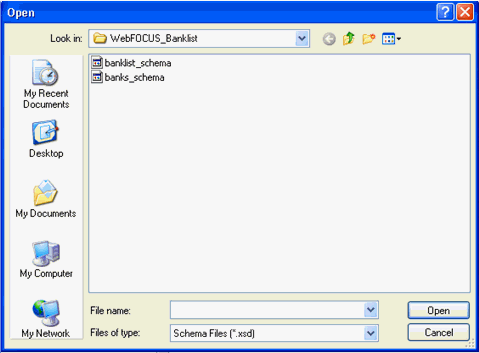
Viewing the Input Structure
You can view the input structure using the context menu. Expand the structure folder, and double-click the name of the structure or select Open from the context menu, as shown in the following image.
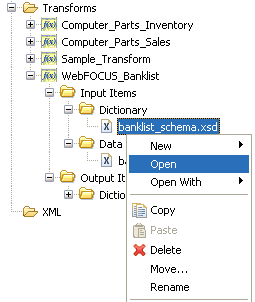
Input Data
|
Topics: |
The Data tab allows you to select and configure an input data file, which contains the sample incoming document for a Transform component.
The following image shows the Input pane, with the Data tab selected.
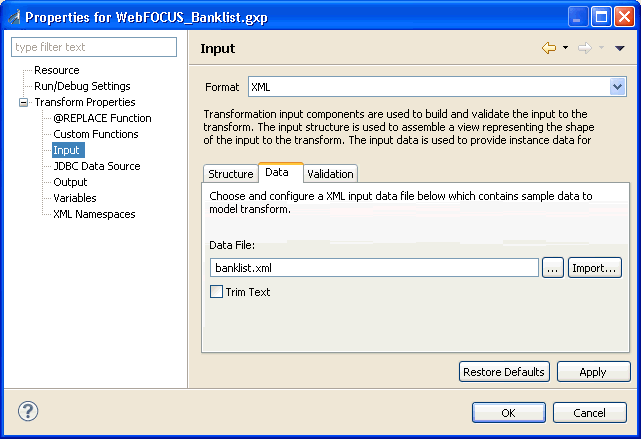
Configuring the Input Data
On the Data tab, you can specify the data file that you want to use to test the Transform component. For more information, see Testing a Transform. You can also overwrite the default data configuration for certain formats. For more information, see Input Formats Reference.
Viewing the Input Data
To view the input data, double-click the data file, or right-click the data file and select Open from the context menu, as shown in the following image.
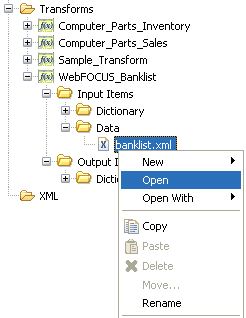
Input Validation
The Validation tab allows you to specify options for validating an incoming document at run time against a specific XML schema or a DTD file. You can also validate the document against the rules contained in a Transform dictionary. We recommend that you use a schema for validation, rather than a DTD file.
The following image shows the Input pane, with the Validation tab selected.
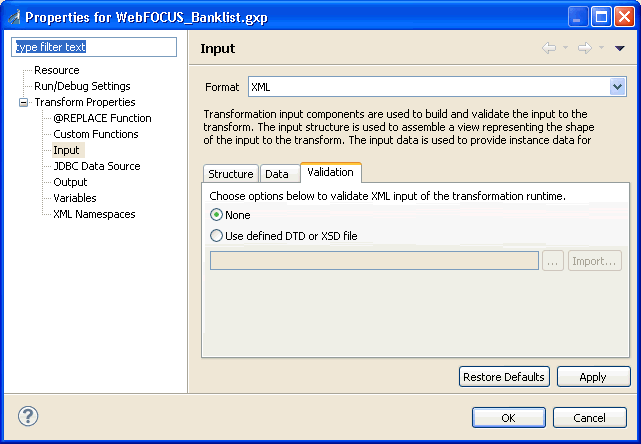
For more information, see Input Formats Reference.
Input Format Reference
|
Topics: |
The following table describes the major concepts and node types used to represent input items.
|
Input Document This is the incoming document or message to which a transformation applies. The following formats are supported:
The input document is displayed on the Input pane as a logical tree of component items, such as groups or elements. For more information, see the Input Document Tree description that follows. Each input item contains a name that identifies the type of item, optionally a number of attributes, or content. |
|
Input Document Tree This is a sample tree of groups, elements, and attributes encoded in the input document. Each item in this tree has exactly one parent, and can have more than one child. The following is a section of an XML input document:  The following is a tree structure representation of the preceding code: 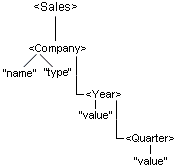 In iWay Transformer, the resulting input document tree is as follows: 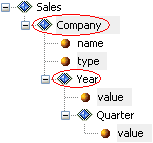 |
|
Group This is a block of data that has a group element as its root. It can contain other groups or elements nested within, as children. Multiple groups can also exist on the same level. A group was formerly called a parent. |
|
Element An element usually belongs to the group as a leaf, which cannot have any other nested groups or elements. |
|
Attribute This is a value associated with a group or element. It consists of a name and an associated textual value. Attributes are used only for XML input. Each group or element can have zero to many attributes. |
|
Parent A parent is a group in relation to the elements or groups contained within it. The input can have more than one parent (root group). In the previous example, the group Company is a parent of the group Year. |
|
Child Node A is called a child of node B, if and only if B is the parent of A. In the previous example, the element Year is a child of the group Company. |
|
Descendant Node A is called a descendant of node B, if either (1) A is a child of B, or (2) A is the child of some node C that is a descendant of B. |
|
Ancestor Node A is called an ancestor of node B, if and only if B is a descendant of A. |
|
Sibling Node A is called a sibling of node B, if and only if B and A share the same parent. Node A is a preceding sibling if it comes before B in the input document tree. Node B is a following sibling if it comes after A in the input document tree. |
CDF Input Properties
The tables in this topic describe the tabs and fields for Common Data Format (CDF) input. It is a conceptual data abstraction for storing, accessing, and manipulating multidimensional data sets.
Note: CDF format is deprecated. iWay Software recommends that you use Fixed Width format instead.
Structure tab: Allows you to configure the dictionary for the CDF input data using the Dictionary Builder interface.
|
Field |
Description |
|---|---|
|
Structure |
Identifies the structure component used for the input dictionary of the Transform component. To locate
the file, type the file name, or click the Browse The following is a sample CDF structure file, which is created when you click the New button. <TransformCDFlayout>
<RecordHeader RecordCount="1" Mode="Ignore" LineFeed="nl"
Format="ASCII">
<Column Name="Name" StartOffset="1" Length="8" />
<Column Name="Title" StartOffset="10" Length="17" />
</RecordHeader>
<RecordDetails>
<RecordLayout Type="20" StartOffset="1" Length="2">
<Column Name="Column1" StartOffset="1" Length="2"/>
<Column Name="Column2" StartOffset="4" Length="7"/>
<Column Name="Column3" StartOffset="12" Length="6"/>
</RecordLayout>
</RecordDetails>
</TransformCDFlayout>
You can use the CDF Dictionary Editor tool to modify the base structure. |
Data tab: Allows you to select and configure a CDF input data file, which contains the sample incoming document for your Transform component.
|
Field |
Description |
|---|---|
|
Data File |
To locate the file, type the file name, or click the Browse button. |
|
Decode data content |
To decode data content from EBCDIC format, select this check box. This check box is not selected by default. |
|
content |
This check box is not selected by default. |
CSV Input Properties
The tables in this topic describe the tabs and fields for the Comma-Separated Values (CSV) input format. In a CSV file, each block of data is separated by a comma. However, iWay Transformer allows for other delimiters. For more information, see the following description of the Delimiter field on the Data tab.
Structure tab: Allows you to configure the dictionary for the CSV input data.
|
Field |
Description |
|---|---|
|
Structure |
Identifies the structure component used for the input dictionary of the Transform component. Typically, this is either the input data file itself, or a CSV file that has an identical structure to the intended input data file. To locate
the file, type the file name, or click the Browse |
|
Restore Defaults |
Clears the Structure field. |
Data tab: Allows you to select and configure a CSV input data file, which contains the sample incoming document for your Transform component.
|
Field |
Description |
|---|---|
|
Data File |
To locate the file, type the file name, or click the Browse button. |
|
Delimiter |
Specifies the delimiter character, which separates the elements of the CSV data. The default value is a comma (,). iWay Transformer can also process files that use other delimiter characters. The files must correspond to the CSV format. |
|
Header is included in the data |
You can select this check box if the header is included in the document. This check box is selected by default. The header typically contains column names. The following excerpt from a sample input.csv file includes a header with the data. The header is in the first line. Country,"Province-Territory Name","Population (in 1000's)","Area Size (in km2)","Type" Canada,"Alberta","3097.5","661185","Province" Canada,"British Columbia","4092.8","948596","Province" . . . |
|
Restore Defaults |
Applies the default values to the Data tab by clearing the Data File field, selecting the Header is included in the data check box, and setting the Delimiter to a comma (,). |
EDI Input Properties
The tables in this topic describe the tabs and fields for the Electronic Data Interchange (EDI) input formats, the following of which are created in a similar fashion:
- EDI HIPAA (Health Insurance Portability and Accountability Act).
- EDI X12. This data format is based on ASC X12 standards. It is used to exchange specific data between two or more trading partners.
- EDIFACT (Electronic Data Interchange For Administration, Commerce, and Transport).
You can edit the data dictionary for EDI input using the Dictionary Builder, and you can store the components in the library for future reuse.
Structure tab: Allows you to configure the metadata for the EDI message.
|
Field |
Description |
|---|---|
|
Header |
Identifies the header component used for the input dictionary of the Transform component. The header contains envelope details that include trading partner information and message layout. To locate the file, type the file name, or click the Browse |
|
Structure |
Identifies the structure component used for the input dictionary of the Transform component. The structure contains the layout and grammar of the document (or transaction of the EDI message). To locate the file, type the file name, or click the Browse button. |
Data tab: Allows you to select and configure an EDI input data file, which contains a sample incoming document for your Transform component.
|
Field |
Description |
|
Segment Delimiter |
Specifies the character that indicates the end of a segment. The default values are:
|
|
Segment Suffix |
Used in combination with a segment delimiter, the segment suffix indicates the end of a segment. You can select a predefined segment suffix from the drop-down list. The default values are:
|
|
Element Delimiter |
Specifies the character that indicates the end of an element. You can select a predefined element delimiter character from the drop-down list. The default values are:
|
|
Component Element Delimiter |
Specifies the character that indicates the end of a component element. You can select a predefined component element delimiter character from the drop-down list. By default, 3A : Colon is used for EDI HIPAA, EDI X12, and EDIFACT formats. |
|
Escape Character |
Specifies the escape character that is used when reading the input data. You can select a predefined escape character from the drop-down list. The default values are:
|
|
Restore Defaults |
Applies default values to the Data tab. |
Validation tab: Allows you to specify options that validate EDI input for the transformation run time.
|
Field |
Description |
|---|---|
|
None |
To skip validation, select this option. This option is selected by default. |
|
Use validation rule defined by the project's input structure |
To validate the incoming document using the rule defined by the Transform component input dictionary, select this option. This option is not selected by default. For EDI HIPAA and EDI X12, selecting this option activates the Ignore NTE Segment check box. |
|
Ignore NTE Segment |
For EDI HIPAA and EDI X12, select this check box if you do not want to validate mapping rules specific to NTE. This check box is not selected by default. This option allows NTE segment translations to appear in the XML document in the same sequence as that of the input document. However, if this option is not checked, specific rules can be applied in the dictionary to position NTE segment translations accordingly. NTE is a floating segment that can occur in any place within a document. It is applicable to versions prior to EDI X12 version 4010. This option is not available for EDIFACT. |
|
Restore Defaults |
Applies the default values to the Validation tab by selecting the None option. |
Fixed Width Input Properties
The tables in this topic describe the tabs and fields for the Fixed Width input format, also called FWF. Fixed Width files are flat files that contain fixed width data fields that constitute records. Records are commonly separated by new line characters. Fixed Width format is very similar to the deprecated CDF format, except for features that are applicable to Fixed Width only, such as looping.
Structure tab: Allows you to select an XML file that represents the data dictionary for the Fixed Width input data.
|
Field |
Description |
|---|---|
|
Structure |
Identifies the metadata component used for the input data dictionary of the Transform component. To locate
the file, type the file name, or click the Browse The following is a sample Fixed Width structure file, which is created when you click the New button. <FIXED_WIDTH>
<RecordHeader>
<Column Name="DESCRIPTION" StartOffset="1"
Length="10" />
</RecordHeader>
<RecordDetails>
<Loop ID="Loop" Req="M" Min="1" Max="1">
<RecordLayout Type="10" StartOffset="1"
Length="2">
<Column Name="Column1" StartOffset="3"
Length="5" />
<Column Name="Column2" StartOffset="8"
Length="5" />
</RecordLayout>
</Loop>
</RecordDetails>
</FIXED_WIDTH> |
Data tab: Allows you to select and configure a Fixed Width input data file, which contains a sample incoming document for your Transform component.
|
Field |
Description |
|---|---|
|
Data File |
To locate the file, type the file name, or click the Browse button. |
|
Record Delimiter |
Specifies delimiter options for the input data file. The record delimiter is a character that defines the boundary between records. The default value is a carriage return. |
|
Trim Columns |
Selected by default, this option is used to trim columns from the input data file. |
|
Restore Defaults |
Clears all fields on the Data tab, and selects the Trim Columns check box. |
IDOC Input Properties
The tables in this topic describe the tabs and fields for the SAP Intermediate Documents (IDOC) input format. IDOCs represent a standard data structure for electronic data interchange between application programs written for SAP systems or between an SAP application and an external program.
You can access IDOCs using the iWay Application Adapter for mySAP ERP in iWay Explorer. For more information, see the iWay Application Adapter for mySAP ERP User’s Guide.
iWay Transformer does not support the collected IDOC files, due to the structural mapping. You must split the IDOC batch documents into the individual IDOC files in order to process them correctly.
Structure tab: Allows you to select a file that represents the data dictionary for the IDOC input data.
|
Field |
Description |
|---|---|
|
Structure |
Identifies the structure component used for the input dictionary of the Transform component. To locate
the file, type the file name, or click the Browse The following is an excerpt from a sample structure file named structure.txt. It is included in the samples provided with the product. BEGIN_RECORD_SECTION BEGIN_CONTROL_RECORD BEGIN_FIELDS NAME TABNAM TEXT Name of table structure TYPE CHARACTER LENGTH 000010 FIELD_POS 0001 BYTE_FIRST 000001 BYTE_LAST 000010 NAME MANDT TEXT Client TYPE CHARACTER LENGTH 000003 FIELD_POS 0002 BYTE_FIRST 000011 BYTE_LAST 000013 . . . |
|
Restore Defaults |
Clears the Structure field. |
Data tab: Allows you to select and configure an IDOC input data file, which contains a sample incoming document for your Transform component.
|
Field |
Description |
|---|---|
|
Data File |
To locate the file, type the file name, or click the Browse button. |
|
Restore Defaults |
Clears the Data File field. |
SWIFT Input Properties
The tables in this topic describe the tabs and fields for the Society for Worldwide Interbank Financial Telecommunication (SWIFT) input format. SWIFT is a messaging and transaction processing format used by worldwide financial organizations.
Structure tab: Allows you to select a data dictionary that represents the SWIFT input data.
|
Field |
Description |
|---|---|
|
Structure |
Identifies the structure component used for the input dictionary of the Transform component. To locate
the file, type the file name, or click the Browse |
Data tab: Allows you to select and configure a SWIFT input data file, which contains a sample incoming document for your Transform component.
|
Field |
Description |
|---|---|
|
Data File |
To locate the file, type the file name, or click the Import button. You can also load the file from your workspace using the Browse button. |
|
Restore Defaults |
Clears the Data File field. |
XML and iWay XML Response Input Properties
The tables in this topic describe the tabs and fields for the XML input formats, which are called XML and iWay XML Response. iWay XML Response is the commonly defined document format used in iWay Service Manager data integration services.
Structure tab: Allows you to select an XML, DTD, or XSD (schema) file that represents the data dictionary for the XML input data.
|
Field |
Description |
|---|---|
|
Structure |
Identifies the structure component used for the input dictionary of the Transform component. It is typically represented as an XSD (schema), DTD, or XML file that describes the incoming message. To locate the file, type the file name,
or click the Browse 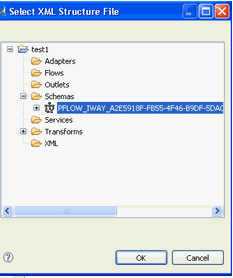 Navigate to the schema reference within the project structure, and click OK. You can load a schema from the file system by clicking the Import button. |
|
Contains Namespace |
Select this check box if the input contains a namespace. This check box is not selected by default. For more information, see Working With Namespaces. |
Data tab: Allows you to select and configure an XML input data file, which contains a sample incoming document for your Transform component.
|
Field |
Description |
|---|---|
|
Data File |
To locate the file, type the file name, or click the Browse button. |
|
Trim Text |
Removes all leading and trailing white space characters from the XML input data file. |
Validation tab: Allows you to specify options that validate the XML input against schemas or DTDs during transformation run time.
|
Field |
Description |
|---|---|
|
None |
To skip validation, select this option. This option is selected by default. |
|
Use validation rule defined in the input data |
To perform validation using the dictionary defined in the input data, select this option. This option is not selected by default. |
|
Use user-defined DTD or XSD file |
To validate the incoming document using an external dictionary, select this option. To locate the dictionary component, XSD (schema), or DTD, type the file name, or click the Browse button. For a dictionary component, we recommend that you use schemas instead of DTDs, because an updated parser is available. |
|
Restore Defaults |
Applies the default values to the Validation tab by selecting the None option. |
JDBC Data Source
The JDBC Data Source category enables you to manage the list of JDBC lookups used by the @JDBCLOOKUP function during transformation mappings. You can define multiple JDBC connections or add a connection from an existing project. In addition, you can specify any predefined function (for example, @SREG) as the URL. For more information, see Working With Functions.
The following image shows the JDBC Data Source pane.
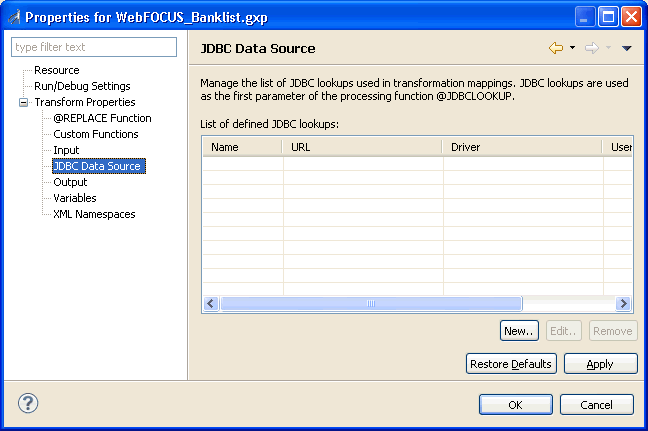
Output
|
Topics: |
The Output category allows you to configure the output properties for the Transform component, according to the expected output requirements, which typically describe the structure.
The following image shows the Output pane, with the Structure tab selected.
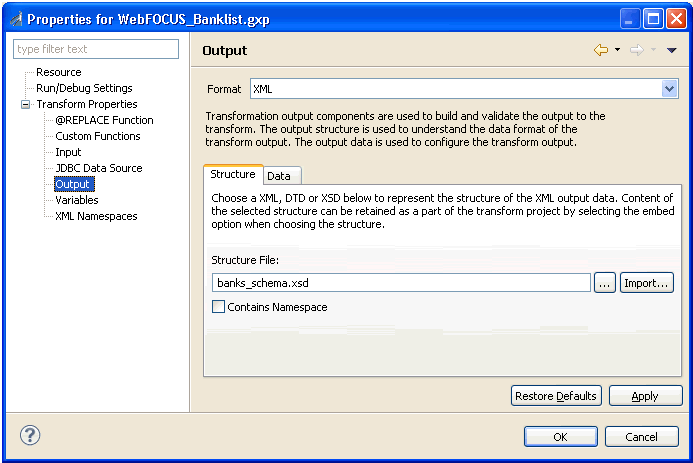
Output Structure
|
Topics: |
The Structure tab allows you to configure the structure of your output.
For more information on using dictionaries, see Dictionary.
Configuring the Output Structure
On the Structure tab, you can specify dictionary components by clicking the Browse button to locate the file on your file system, or by typing the name of the file in the component field.
For supported library formats like EDI and SWIFT, the option to select a dictionary from the system library is provided. For XML and iWay XML Response input formats, the option to import a schema from the iWay Registry, an iWay Service Manager configuration, an iWay Web service, or an Ebix archive is provided. For more information, see XML, iWay XML Embedded Request, and iWay XML request Output Properties.
The following image shows the Open dialog box that is displayed when you click the Import button next to a dictionary component field, for example, Structure.
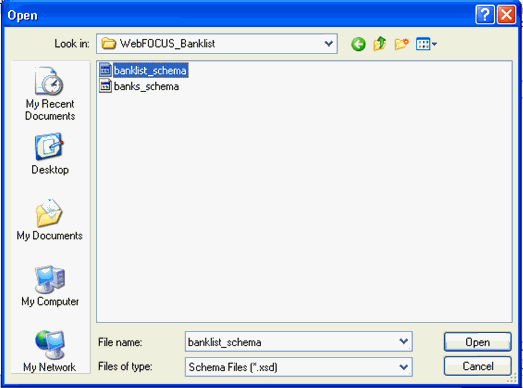
Viewing the Output Structure
To view the output dictionary, double-click the data file, or right-click the data file and select Open from the context menu, as shown in the following image.
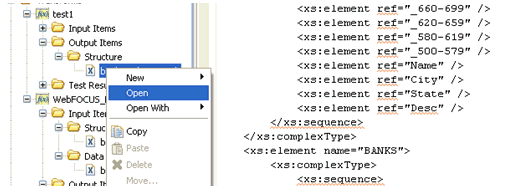
Output Data
|
Topics: |
The Data tab allows you to configure output data. The following image shows the Output pane, with the Data tab selected.
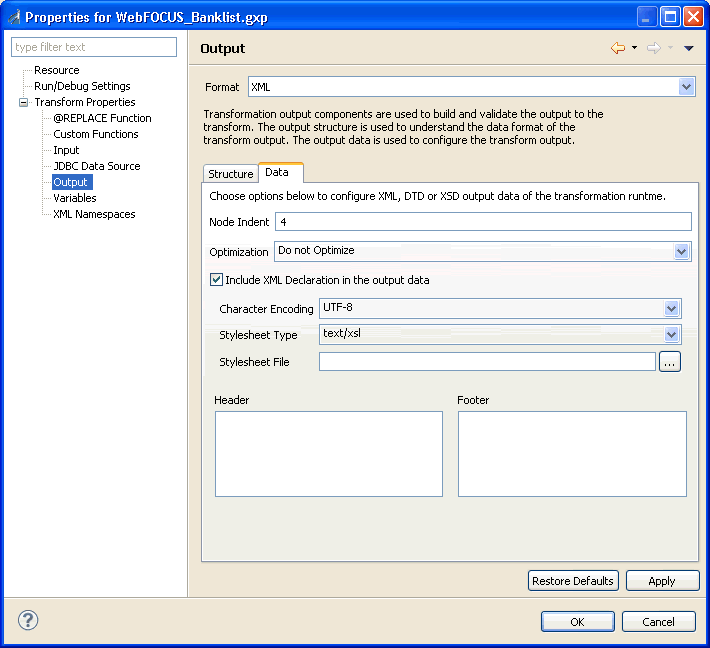
Configuring the Output Data
On the Data tab, you can configure the output data for the Transform component that will be used during run time. For more information, see Output Formats Reference.
Output Validation
The Validation tab allows you to specify options that validate the output document at run time. For more information, see Output Formats Reference.
Output Format Reference
|
Topics: |
This topic provides a reference for the output formats supported by iWay Transformer.
CDF Output Properties
CDF format is deprecated. iWay Software recommends that you use Fixed Width format instead.
The tables in this topic describe the tabs and fields for Common Data Format (CDF) output. It is a conceptual data abstraction for storing, accessing, and manipulating multidimensional data sets.
Structure tab: Allows you to configure the structure for the CDF output data.
|
Field |
Description |
|---|---|
|
Structure |
Identifies the structure component used for the output dictionary of the Transform component. To locate
the file, type the file name, or click the Browse The following is a sample CDF structure file, which is created when you click the New button. <TransformCDFlayout> <RecordHeader RecordCount="1" Mode="Ignore" LineFeed="nl" Format="ASCII"> <Column Name="Name" StartOffset="1" Length="8" /> <Column Name="Title" StartOffset="10" Length="17" /> </RecordHeader> <RecordDetails> <RecordLayout Type="20" StartOffset="1" Length="2"> <Column Name="Column1" StartOffset="1" Length="2"/> <Column Name="Column2" StartOffset="4" Length="7"/> <Column Name="Column3" StartOffset="12" Length="6"/> </RecordLayout> </RecordDetails> </TransformCDFlayout> |
Data tab: Allows you to configure CDF output data.
|
Field |
Description |
|---|---|
|
Padding |
Specifies the character used for padding empty spaces. If you leave this field blank, iWay Transformer uses a blank space for padding. |
|
Align |
Specifies the alignment of the output. Left-justified text (the default value) is aligned to the left side of each field. Right-justified text is aligned to the right side. For example, consider the following dictionary file: <TransformCDFlayout>
<RecordHeader RecordCount="1" Mode="Ignore"
LineFeed="nl" Format="ASCII">
<Column Name="ReportTitle" StartOffset="1"
Length="2"/>
</RecordHeader>
<RecordDetails>
<RecordLayout Type="NA" StartOffset="1"
Length="2">
<Column Name="MSG_ID "
StartOffset="1" Length="8"/>
<Column Name="ITEM_UNIQUE_ID "
StartOffset="9" Length="20"/>
<Column Name="ITEM_CASE_NUM "
StartOffset="30" Length="18"/>
<Column Name="ORIGIN "
StartOffset="49" Length="8"/>
.
.
.
Left-aligned data is displayed as: ABC 55 777 XXX Right-aligned data is displayed as: ABC 55 777 XXX |
|
Encode |
To encode the data in EBCDIC format, select this check box. By default, this check box is not selected. |
|
Restore Defaults |
Applies the default values to the Data tab, by clearing the Padding field, selecting Left from the Align field drop-down list, and deselecting the Encode check box. |
CSV Output Properties
The tables in this topic describe the tabs and fields for the Comma-Separated Values (CSV) output format. In a CSV file, each piece of data is separated by a comma. However, iWay Transformer allows for other delimiters. For more information, see the following description of the Delimiter field on the Data tab.
Structure tab: Allows you to configure the dictionary for the CSV output data.
|
Field |
Description |
|---|---|
|
Structure |
Identifies the structure component used for the output dictionary of the Transform component (optional). To
locate the file, type the file name, or click the Browse |
Data tab: Allows you to configure CSV output data.
|
Field |
Description |
|---|---|
|
Delimiter |
Sequence of one or more characters specifying the border between column fields. The default value is a comma (,). Although CSV stands for comma-separated values, iWay Transformer can process files that use other delimiter characters. The files must correspond to the CSV format. |
|
Header is included in the data |
You can select this check box if the header is included in the document. This check box is selected by default. The header typically contains column names. The following excerpt from a sample input.csv file includes a header with the data. The header is in the first line. Country,"Province-Territory Name","Population (in 1000's)","Area Size (in km2)", "Type" Canada,"Alberta","3097.5","661185", "Province" Canada,"British Columbia","4092.8","948596","Province" . . . |
|
Always Add Quotes |
To add quotation marks around the output values, select this check box. This check box is not selected by default. |
|
Restore Defaults |
Applies the default values to the Data tab, by setting the Delimiter to a comma (,), selecting the Header is included in the data check box, and deselecting the Always Add Quotes check box. |
EDI Output Properties
The tables in this topic describe the tabs and fields for the Electronic Data Interchange (EDI) output formats, the following of which are created in a similar fashion:
- EDI HIPAA (Health Insurance Portability and Accountability Act).
- EDI X12. This is a data format based on ASC X12 standards. It is used to exchange specific data between two or more trading partners.
- EDIFACT (Electronic Data Interchange For Administration, Commerce, and Transport).
Structure tab: Allows you to configure the metadata for the EDI output message.
|
Field |
Description |
|---|---|
|
Header |
Identifies the header component used for the output structure of the Transform component. The header contains envelope details that include trading partner information and message layout. To
locate the file, type the file name, or click the Browse |
|
Structure |
Identifies the structure component used for the output dictionary of the Transform component. The structure contains the layout and grammar of the document (or transaction of the EDI message). To locate the file, type the file name, or click the Browse button. |
Data tab: Allows you to configure an EDI output data file.
|
Field |
Description |
|---|---|
|
Segment Delimiter |
Specifies the character that indicates the end of a segment. The default values are:
|
|
Segment Suffix |
Used in combination with a segment delimiter, the segment suffix indicates the end of a segment. You can select a predefined segment suffix from the drop-down list. The default values are:
|
|
Element Delimiter |
Specifies the character that indicates the end of an element. You can select a predefined element delimiter character from the drop-down list. The default values are:
|
|
Component Element Delimiter |
Specifies the character that indicates the end of a component element. You can select a predefined component element delimiter character from the drop-down list. By default, 3A : Colon is used for EDI HIPAA, EDI X12, and EDIFACT formats. |
|
Escape Character |
Specifies the escape character that is used when reading the output data. You can select a predefined escape character from the drop-down list. The default values are:
|
Validation tab: Allows you to specify options that validate EDI output of the transformation run time.
|
Field |
Description |
|---|---|
|
None |
To skip validation, select this option. This option is selected by default. |
|
Use validation rule defined by the project's output structure |
To validate the transform using the rule defined by the Transform component output structure, select this option. This option is not selected by default. For EDI HIPAA and EDI X12, selecting this option activates the Ignore NTE Segment check box. |
|
Ignore NTE Segment |
For EDI HIPAA and EDI X12, select this check box if you do not want to validate mapping rules specific to NTE. This check box is not selected by default. This option allows NTE segment translations to appear in the XML document in the same sequence as that of the output document. However, if this option is not checked, specific rules can be applied in the dictionary to position NTE segment translations accordingly. NTE is a floating segment that can occur in any place within a document. It is applicable to versions prior to EDI X12 version 4010. This check box is not available for EDIFACT. |
|
Restore Defaults |
Applies the default values to the Validation tab by selecting the None option. |
Fixed Width Output Properties
The tables in this topic describe the tabs and fields for the Fixed Width output format, also called FWF. Fixed Width files are flat files that contain fixed width data fields that constitute records. Records are commonly separated by carriage return (new line) characters.
Structure tab: Allows you to select an XML file that represents the data dictionary for the Fixed Width output data. The data dictionary describes the structure of the output message.
|
Field |
Description |
|---|---|
|
Structure |
Identifies the structure component used for the output dictionary of the Transform component. To locate
the file, type the file name, or click the Browse The following is a sample Fixed Width structure file, which is created when you click the New button. <FIXED_WIDTH>
<RecordHeader>
<Column Name="DESCRIPTION" StartOffset="1"
Length="10" />
</RecordHeader>
<RecordDetails>
<Loop ID="Loop" Req="M" Min="1" Max="1">
<RecordLayout Type="10" StartOffset="1"
Length="2">
<Column Name="Column1" StartOffset="3"
Length="5" />
<Column Name="Column2" StartOffset="8"
Length="5" />
</RecordLayout>
</Loop>
</RecordDetails>
</FIXED_WIDTH> |
|
Restore Defaults |
Clears the Structure field. |
Data tab: Allows you to configure a Fixed Width output data file.
|
Field |
Description |
|---|---|
|
Record Delimiter |
Specifies delimiter options for an output data file. The record delimiter is a character that defines the boundary between records. The default value is a carriage return. |
|
Padding |
Specifies the character used for padding empty spaces. If you leave this field blank, iWay Transformer uses a blank space for padding. |
|
Align |
Specifies the alignment of the output. Left-justified text (the default value) is aligned to the left side of each field. Right-justified text is aligned to the right side. For example, consider the following dictionary file: <RecordDetails>
<RecordLayout Type="NA" StartOffset="1"
Length="2">
<Column Name="MSG_ID "
StartOffset="1" Length="8"/>
<Column Name="ITEM_UNIQUE_ID "
StartOffset="9" Length="20"/>
<Column Name="ITEM_CASE_NUM "
StartOffset="30" Length="18"/>
<Column Name="ORIGIN "
StartOffset="49" Length="8"/>
.
.
.
Left-aligned data is displayed as: ABC 55 777 XXX Right-aligned data is displayed as: ABC 55 777 XXX |
|
Encode |
When selected, encodes your data in EBCDIC format. By default, this check box is not selected. |
|
Trim Columns |
Removes trailing spaces from columns in the output data file. By default, this check box is selected. |
|
Support Record ID |
Returns the support record ID flag. By default, this check box is selected. |
|
Restore Defaults |
Applies the default values to the Data tab, by clearing the Record Delimiter field and Padding field, selecting Left from the Align field drop-down list, and selecting the Trim Columns check box. |
HTML Output Properties
The following table describes the tabs and fields for the HTML output format.
Data tab: Allows you to configure HTML output data.
|
Field |
Description |
|---|---|
|
Mode |
Specifies the format of the HTML output. Choose either Form or Table (the default value) format. |
|
Stylesheet Type (Optional) |
Specifies the format of the style sheet that you are using. The default value is text/css. |
|
Stylesheet File (Optional) |
Identifies the style sheet that is applied to your output. To locate the file, type the file name, or click the Browse or Import button. This file must match the selected file type. |
|
Header (Optional) |
Specifies header comments that are included in the output structure as necessary. You can specify one or more lines, separated by a pipe symbol (|). For example, This information|is inserted|into the output adds the following header to the output: <!--This information--> <!--is inserted--> <!--into the output--> |
|
Footer (Optional) |
Specifies footer comments that are included in the output structure as necessary. You can specify one or more lines, separated by a pipe symbol (|). For example, This information|is inserted|into the output adds the following footer to the output: <!--This information--> <!--is inserted--> <!--into the output--> |
|
Restore Defaults |
Applies the default values to the Data tab, by selecting Form from the Mode drop-down list, selecting text/css from the Stylesheet Type drop-down list, and clearing the Stylesheet File, Header, and Footer fields. |
IDOC Output Properties
The following table describes the tabs and fields for the SAP Intermediate Documents (IDOC) output format. IDOCs represent a standard data structure for electronic data interchange between application programs written for SAP systems or between an SAP application and an external program.
You can access IDOCs using the iWay Application Adapter for mySAP ERP in iWay Explorer. For more information, see the iWay Application Adapter for mySAP ERP User’s Guide.
iWay Transformer does not support the collected IDOC files, due to the structural mapping. You must split the IDOC batch documents into the individual IDOC files in order to correctly process them.
Structure tab: Allows you to select a file that represents the data dictionary of the IDOC output data.
|
Field |
Description |
|---|---|
|
Restore Defaults |
Clears the Structure field. |
SWIFT Output Properties
The following table describes the tabs and fields for the Society for Worldwide Interbank Financial Telecommunication (SWIFT) output format. SWIFT is a messaging and transaction processing format used by worldwide financial organizations.
Structure tab: Allows you to select a data dictionary that represents the SWIFT output data.
|
Field |
Description |
|---|---|
|
Structure |
Identifies the structure component used for the output dictionary of the Transform component. To locate
the file, type the file name, or click the Browse |
|
Import Dictionary from System Library |
Allows you to add a data dictionary from a system library. |
XML, iWay XML Embedded Request, and iWay XML Request Output Properties
The tables in this topic describe the tabs and fields for the XML, iWay XML Embedded Request, and iWay XML Request output formats.
Structure tab: Allows you to select an XML, DTD, or XSD (schema) file that represents the data dictionary for the XML output data.
|
Field |
Description |
|---|---|
|
Structure |
Identifies the structure component used for the output dictionary of the Transform component. It is typically represented as an XSD (schema), DTD, or XML file that describes the outgoing message. To locate the file, type the file name, or click
the Browse The following is an example of an iWay XML Embedded Request: <?xml version="1.0" encoding="UTF-8" ?>
<Insert_DW_Customer>
<iway>
<request agent="XDJdbcAgent">
<connection>
<dsn>DW_SQL</dsn>
<user>iwaytest</user>
<password>ENCR(4485729374774629470
110485)</password>
<sql>
<query>INSERT INTO StageDimCustomer (Customer,
CustomerName, Address, ARGroup, GroupName, Owner,
SalesRep, Jurisdiction, ShippingWarehouse,
DeliveryDay, CustomerCity, CustomerState,
CustomerZip, Beantown, Bullseye, WarehouseTransfer)
VALUES (555, 'DOLLAR STORE NO. 150 ', '33 BAY
VIEW ROAD ', 'H6A', SAMPLE, Inc. ', '
', 31, 0, 9, '4', '', 'NY', '13454', '', '', 'YES')
</query>
</sql>
</connection>
</request>
</iway>
</Insert_DW_Customer>
You can load a schema from the server registry or from a server configuration by selecting Import Schema, From Server. Another option is to load the schema from one of the available iWay Web services by selecting Import Schema, From Webservice. You can also load the schema from an Ebix archive by selecting Import Schema, From Ebix. |
|
Contains Namespace |
Select this check box if the output contains namespaces. This check box is not selected by default. You can also specify a namespace for individual items. For more information, see Working With Namespaces. |
Data tab: Allows you to configure an XML output data file.
|
Field |
Description |
|---|---|
|
Node Indent |
Indicates the number of spaces used to indent the node. The default value is 4. For example, if the node indent is 0, all elements are aligned at the margin, as follows: <a> <b> </b> <c> </c> </a> If the node indent is 4, all elements except the root are indented 4 spaces, as follows: <a>
<b>
</b>
<c>
</c>
</a> |
|
Optimization |
Enables you to retain or omit empty elements and attributes. To retain empty elements and attributes, select Do Not Optimize. This is the default value. To omit empty elements and attributes, select Remove All Empty Nodes. To omit empty elements, including empty nested groups, select Remove Empty Group Nodes. |
|
Include XML Declaration in the output data |
Automatically inserts an XML declaration into the output data structure. This option is selected by default. |
|
Character Encoding |
Select the character encoding from the drop-down list. By default, UTF-8 is selected. |
|
Stylesheet Type (Optional) |
Select either text/xsl or text/css. By default, text/xsl is selected. This option is an HTML property that is rarely used in plain XML format. |
|
Stylesheet File (Optional) |
To locate the style sheet file that you want to use for the output, type the full path, click Browse, or click Import to navigate to the file. This option is an HTML property that is rarely used in plain XML format. |
|
Header (Optional) |
Specifies the header information that you want in the output. This option is an HTML property that is rarely used in plain XML format. |
|
Footer (Optional) |
Specifies the footer information that you want in the output. This option is an HTML property that is rarely used in plain XML format. |
Variables
The Variables category enables you to manage the list of variables that you can use for the output node values. Using variables improves the readability and usability of the output. You can use a defined variable in the output node mapping value through the @GETCONSTANT or @VARIABLE function.
The following image shows the Variables pane.
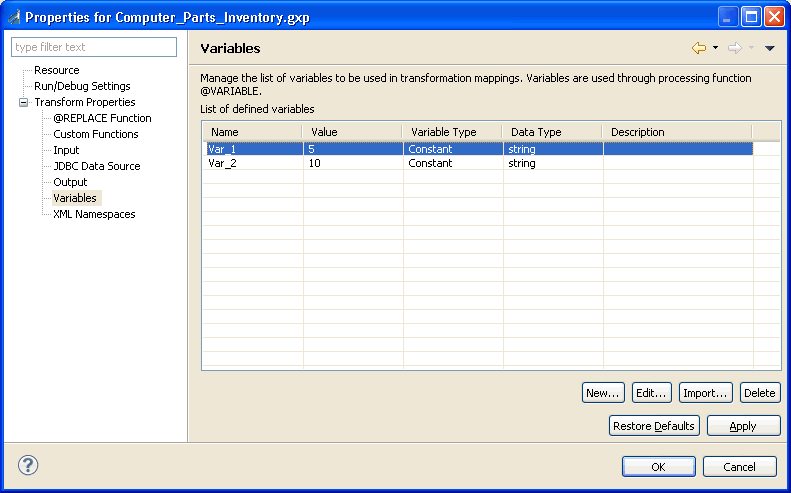
The Variables category is not upward compatible. Transform components with defined variables do not function properly in earlier versions of iWay Transformer. Projects must use global constants in earlier versions of iWay Transformer, as shown in the following image.
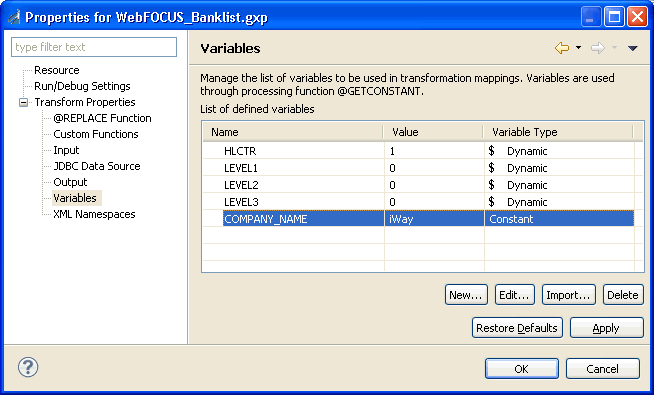
Variable is a new mapping value type. It represents an intermediate value used globally during the life of a transformation. You can define two types of variables, dynamic and constant:
- The value of a dynamic variable can change during the course of a transformation (run time). As a result, a dynamic variable is an ideal candidate for supporting elements of the transformation, such as loop counters or global data storage. The use of variables is much less resource-expensive, and more efficient, than that of Special Registers (SREGs). Consequently, we recommend that you use variables for any values that you do not need to make available after the execution of the transformation.
- Constant variables (formerly known as global constants) represent a subset of the scope of a variable. As a result, you can now define a constant value as a variable of type constant. This feature is backward compatible with the implementation of global constants from previous releases of iWay Transformer.
You must define the following parameters for a new variable:
- Name. The name of the variable.
- Value. The value of the variable.
- Variable Type. The type of the variable, Dynamic or Constant.
- Data Type. The data type for the value of the variable. For example, the data type for a counter is Number.
- Description (optional). A brief description of the variable and its functionality according to your design.
The following image shows the Add New Variable dialog box.
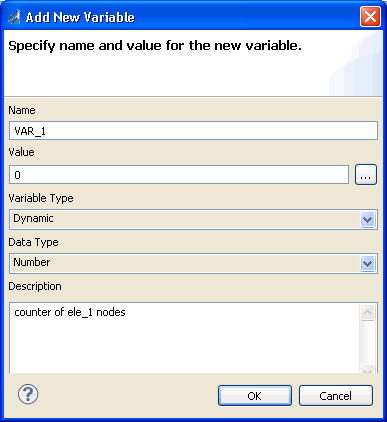
After you define and initialize the variable in the Variables category, you can use it within the workspace of a project. The full list of available variables is added to the type of nodes to add, under the Variable option on the context menu of the mapping workspace. That way, it can be added within your output mappings and assigned values.
The following image shows the Variable option on the context menu.
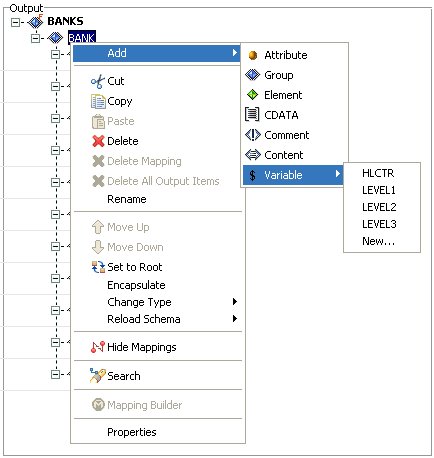
You can also import variables from other Transform components. Variables in the iWay Transformer workspace are identified by the dollar sign ($) icon.
You can use two predefined processing functions in iWay Transformer to manipulate variables. They support two different signatures, depending on the action (ADD, GET, or SET) that needs to be performed over the referenced variable:
- @VARIABLE(name, action, value). Returns the value of the specified variable.
- @VARIABLE(name, action). Returns the action of the specified variable.
The following table describes the arguments for each function.
|
Name |
Description |
Value |
Default |
Required |
|---|---|---|---|---|
|
name |
Variable name |
N/A |
VAR_1 |
Yes |
|
action |
Action that is performed by this function |
|
2 (ADD) |
Yes |
|
value |
Value that is used in the action |
N/A |
1 for number. Null for string. |
No |
Standard drag-and-drop functionality applies to the variable functions, as shown in the following image of the Mapping Builder.
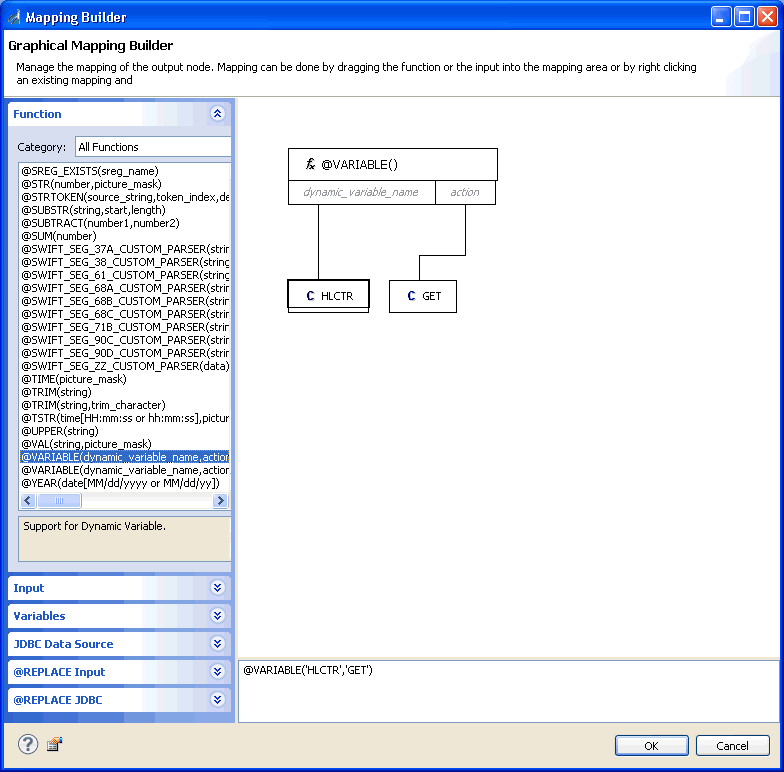
You can change the variable name and action using the Output Node Properties dialog box, as shown in the next image.
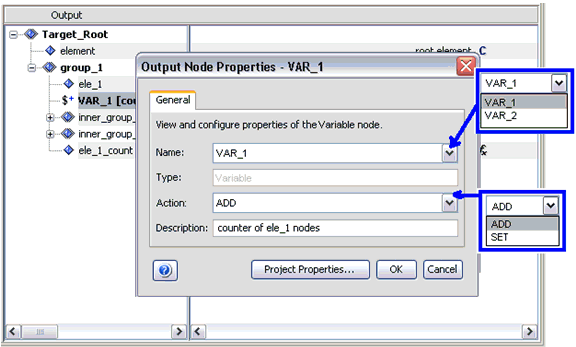
By default, if the variable is numeric, an increment of 1 is added to the output structure, as shown in this image.

Incrementing the variable by -1 performs a subtraction.
You can change the output node properties for a variable from ADD to SET to assign a value to the variable node, instead of an increment.
The following image shows the Action drop-down list, from which you can change ADD to SET.

You can also insert the @VARIABLE function inside a formula that is developed using the Mapping Builder (for example, as a result of the @IF condition), just like any regular predefined iWay Transformer function.
XML Namespaces
The XML Namespaces category enables you to load XML namespaces from other projects, or create your own. The following image shows the XML Namespaces pane.
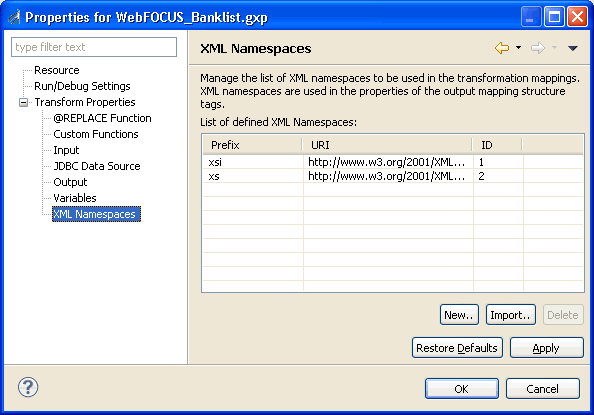
For more information on defining XML namespaces, see Working With Namespaces.


 button.
button.